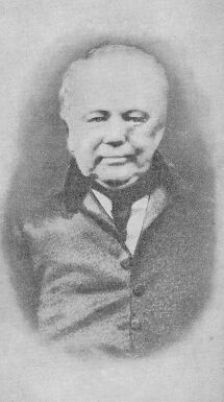Australia is big.
Really big. You just won’t believe how vastly, hugely, mind-bogglingly big it is. I mean, you may think it’s a long way down the road to the chemist’s, but that’s just peanuts to Australia.
I hijacked Douglas Adams’ quote from the Hitchhikers Guide to the Galaxy for the intro to this blog. I hope he won’t mind as it fits this part of our journey so well. I’ve stolen some more of his lines later too. I’m a fan, what can I say.
This blog is not about a place as such but about a journey. We’re on our way to Coober Pedy. It’s been a destination we have wanted to visit and, on a whim, decided that this is where we would go after Sydney. So here we are, on our way to Coober Pedy. We are stopping overnight at Katoomba, West Wyalong, Mildura, Broken Hill, Wilpena Pound and Woomera. It’s about 2,500 kms and we plan to take about 8 days to get there. Lets go.

First stop – Katoomba

Katoomba is a town in the Blue Mountains. It’s a popular tourist destination just 1.5 hours drive out of Sydney. It’s a historical town which is evident in it’s buildings. It looks like it was once glorious but it fell into hard times and is now gaining a bit of a resurgence. Surprisingly, houses are still relatively inexpensive here. Tourism is its main income nowadays. It has a lot going for it tourism wise, its placed in one of the most generously visually stunning places on the planet. The backdrop of the Blue Mountains is spectacular.

When we pulled up at Katoomba and got out of the car, instantly, the chill hit us. It was 4°C in the mountains according to the car temperature gauge, the cold wind making it feel even colder. Quickly grabbing our warm coats we checked in at the 3 Explorers Motel. It was quite late as we had to finish work in Sydney before we left. The Motel was about 250 metres from Echo Point…. wait! It’s at this point I should mention I knew nothing about Katoomba or the Blue Mountains. I had no idea what to expect. It was getting dark when we checked in and the owner of the Motel prioritised the many tourist destinations around Katoomba into a few spots we had to visit while we were here. The first place he said was Echo Point, it was just 250 metres away and there was a bar/cafe there. Perfect. Pulling on our beanies and gloves we set off for Echo Point, whatever that is, as we had no idea at this point. Turns out it’s a bit amazing.

The Echo Point lookout overlooks the Blue Mountains and the 3 Sister’s rock formation. It’s one of the Australian versions of the American Grand Canyon. I’ve been to the Grand Canyon. Now don’t get me wrong, it’s very special and majestic and grand and huge and everything, I just think everything about the Blue Mountains was better. More luscious, more vast, more accessible, more granderer, morer hugerer, just more everything. I was blown away. I didn’t expect this.
It was getting dark so we took a quick phone selfie (naturally) and visited the cafe / bar overlooking the mountains for a beer and something to eat.

As we sat and ate and watched the sun setting I did a quick mental calculation (used the app) and worked out where the sun would rise. Continuing the homage to Douglas Adams for a bit longer, the designer of this particular range of mountains, probably a student of Slartibartfast, had paid great attention to the rotation of the planet and had oriented and placed the really pretty parts of these mountains so they would catch the early morning sun just perfectly to make it easy for future photographers to get a decent picture. Jenni and I agreed we would set our alarms early and make sure we were back here to watch the sun rise and for me to get a picture for the blog. Luckily at this time of the year that’s about 7:00am so no real hardship then. We were there at 6:30am and we were not the first there. It was cold and there was a sharp wind but about 20 hardy photographer types were already there and had grabbed the best positions with their Gitzo carbon fibre tripods and Lee ND Grad filters and white Canon professional lenses. It just reinforced our idea that this was going to be a spectacle. We weren’t disappointed.

The golden rays of early dawn caught the tips of the 3 sisters perfectly and lit up the escarpment across the valley. The early morning mists still sat cooperatively in the valley perfectly placed in the distance adding that bit of texture and ambience. Slartibartfast’s student did a fine job. He should be proud.

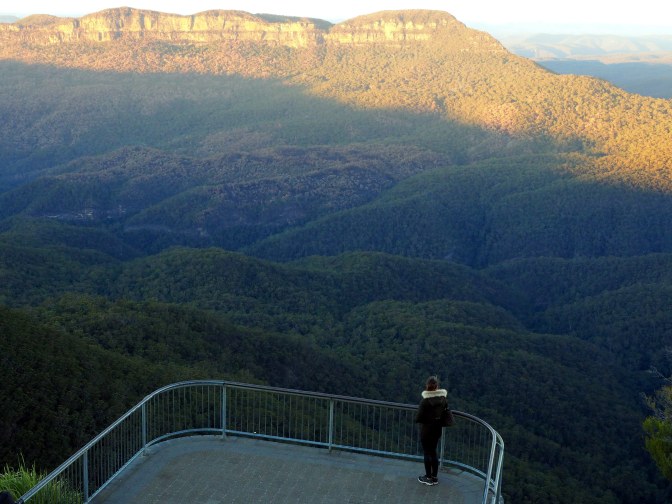
I recommend you go here and see this spectacle for yourself but if you can’t Google have kindly worked their Streetview magic on this place here.
We departed for breakfast to Wentworth Falls picnic area. We’d packed all our essentials and quickly set up camp and cooked up our own breakfast feast.

We had eggs and beans and toast and coffee all set in the marvelous backdrop of the Blue Mountains.
After breakfast we went walking down some of the tracks. We wanted to see Wentworth Falls and the ancient stone staircase that winds down into the valley.


The path to Wentworth Falls was quite easy, but past Wentworth Falls the path got very exciting. Although this bit in the photograph was flat the rest was steep, very steep steps down the cliff face. And as we all know if you want to get back to where you started you have to climb back up. It wasn’t too serious but not for the unfit.

Kudos to the people who built this. Charles Darwin stayed in Wentworth Falls in 1836, and took a walk along the ridge we had traversed. There is now a longer walk named inventively the Charles Darwin Walk.
After Wentworth Falls we went to the 3 Sisters walk which takes you down and into the rock formation pictured earlier. Here the steps also were steep but it didn’t deter the hundreds of tourists.

Jenni found a sister at the 3 Sisters.

It’s a pity they were closed for adventure sports, I was thinking of doing a bit of climbing.
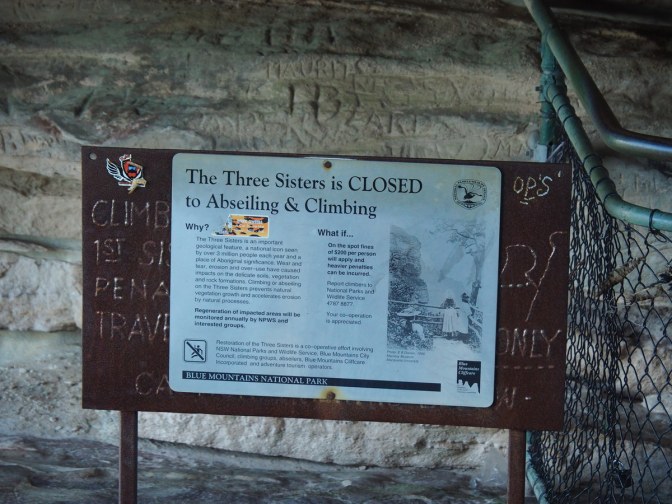
This is what Echo Point Lookout looks like from the 3 Sisters

And this is what it looked like when the 3 explorers saw it.

Who are the 3 explorers? Read on to find out.
3 Explorers
The 3 Explorers our Motel was named after were called Wentworth, Lawson and Blaxland who were some of the first settlers to find a way across the Blue Mountains. This was in 1813. They didn’t actually make it across but made enough of an impact for all 3 to be awarded 1,000 acres of land each on the west side of the mountains.
Blaxland had the foresight to plant some vines on his 1,000 acreas and made some of the earliest Australian wine. By 1822 he was the first person to export Australian wine. Without Gregory Blaxland, this classic Monty Python sketch would never have happened. For that, thank you Gregory.
The Ultratrail

Aussies are tough. To demonstrate and confirm their toughness they put on this thing called the Ultratrail each year in Katoomba. It was going on when we arrived. The premise is this, the circuit is 100kms, down one side of the valley, up the other side, along the top a bit, down again and across, up the valley again to the top and along a bit more and do that two more times. In one day. I did the Belfast Marathon once which is flat and only 42 kms and someone died on that. Accurately I was in a relay team and only did 8 kms but hey, I’m not one for spoiling a good story with facts as those who read these blogs know well. The comparison though should be obvious.
The day after the Ultratrail finished we had lunch in a bar in Katoomba and it was full of burly Sheela’s and Bruce’s in “I did the Ultratrail and it was bloody easy” Official Ultratrail Finisher T-Shirts eating massive piles of seriously unhealthy deep fried food and drinking pints of beer like there was a lock in. Made me think, “Nice T-shirt. I have the diet regime for Ultra Trail running obviously. Maybe I should give it a go.”
The next leg of this trip takes us to West Wyalong but before I leave this part of the blog I must say, if you ever get the chance visit here, do it. However long it takes, the journey will be worth it.
West Wyalong
The drive to West Wyalong was pretty but uneventful. We did go through Bathurst, motor racing capital of Australia though. It hosts the Bathurst 12 Hour motor race each February, the Bathurst Motor Festival every Easter, and the Bathurst 1000 motor race each October. Some of my friends race there and I can’t wait to see them when I get back to Brisbane and tell them how I drove through Bathurst and didn’t stop.
West Wyalong itself was a quiet small town. The one thing I noticed about it was the big Eff You to the usual national retail outlets. There wasn’t a recognisable sign anywhere, no Coles or Woolies supermarket, no BWS or Liquorland bottle shops, no Bunnings or Mitre 10, not even an IGA grocery store we have come to depend on the these out of the way places. No, West Wyalong stores were all locally owned enterprises. Good on you West Wyalong, ploughing your own furrow. I like that. Not enough to take a picture though, so we move on to the journey to Mildura the next day.
The reason this picture is here is a) because I am a Doctor Who fan, and b) is there to break up a long wordy bit.
An explanation of where this was encountered appears later in this blog.

Mildura
The drive from West Wyalong to Mildura is 550 kms and was going to take about 7 hours with stops. One thing this Vagabonding experience has taught me is the journey is a big part of the experience. I’ve not mentioned it before but on these long roads through the agricultural districts of Australian this is how it goes. Road with no towns for 30 kms, road sign with town name, MASSIVE grain silos, road sign with town name wishing you a safe journey, repeat. The fields are gigantic here, this part of Australia is known as the wheat belt and produces much of the grain for this country. We saw single fields bigger than entire counties back in Ireland. It’s a remarkable place, as an ex-farmer I was enthralled with this scenery. The ground is so flat you can see the curve of the earth.

We stopped for petrol in a grain silo town called Weethalle. The petrol station was one of those multi functional establishments you get in the rural communities that sells animal feed and wellington boots and fan belts and pet supplies and overalls and hats and pitchforks and tractors and petrol. I pulled up at the pumps and tried to fill up the car but the pump handles were secured by a padlock. I stood there inanely tugging at the handle, then realising that was futile after a while I walked into the shop to see if they knew some idiot had padlocked the pump handles. The door opened but the shop was empty. I walked back to the car and stood there processing all the data but not really knowing what our next move was. Fortunately a lady appeared from nowhere with a bunch of keys and greeted us warmly. She unlocked the pump as if that was normal and started to fill up the car. Afterwards Jenni and I tried to think of the last time we were served at a petrol pump, it was many years ago.
Across the road Jenni spied another painted grain silo.

We asked the petrol pump lady about it. She said that just the day before there was a big ceremony celebrating the painted silo appearing on a postage stamp. She said the tiny town of Weethalle tripled its population to 500 with visitors for the the opening of the Silo Art Project, the first of it’s kind in New South Wales.

Painted silos were once a Victoria state thing. In 2015 an Brisbane artist called Guido van Helten painted a mural on a disused silo in the Victorian village of Brim. Overnight Brim became a tourist hotspot with people detouring to see the grand visage. Other Victorian towns followed their lead creating the Silo Art Trail. Weethalle is in Bland Shire, not bland anymore.
The mural detail is amazing close up.

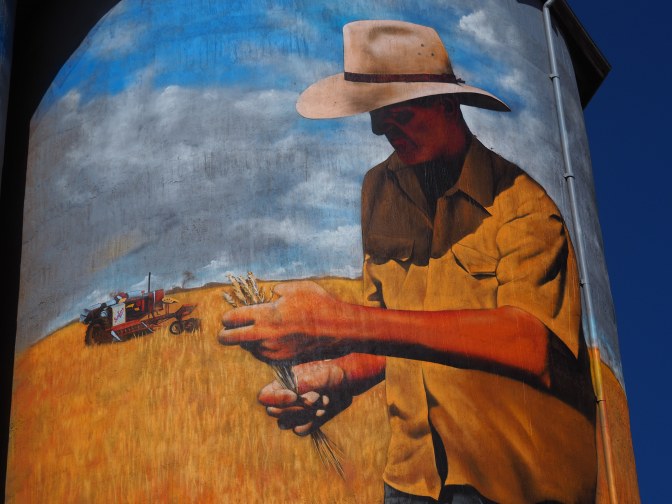
Leaving Weethalle towards Mildura the wheat fields carried on stretching forever. When passing through Rankin Springs I spied a familiar sight at the side of the road, a TARDIS no less. As a Doctor Who fan from the Third Doctor, the Jon Pertwee era, I had to stop.

After a bit of Googling I found out the yard and all its treasures are the work of local artist Wally Lamont. Also a Doctor Who fan. That’s him on this picture, you can read about him here. Next time I go through Rankin Springs I’m stopping for a chat.

Onwards we drove.
The wheat fields turned gradually into cotton fields. The small balls of cotton lined the roads blown off the fields and caught in the course grasses.

Neatly rowed cotton plants stretched across the landscape.

This is a picture of me taking the picture above

This is a picture of Jenni taking a picture of me just after taking the picture above.
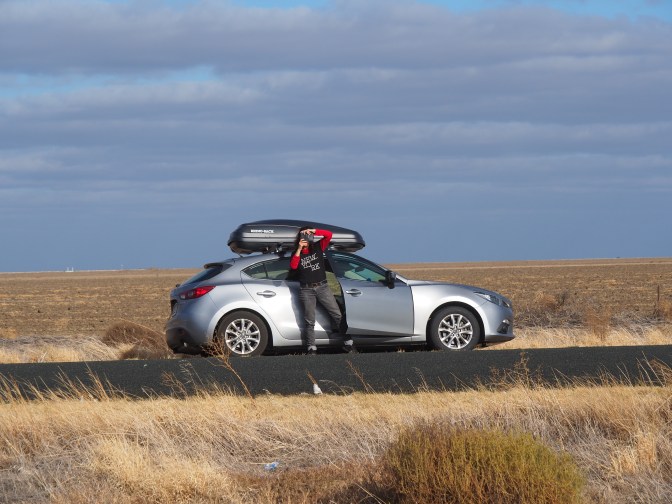
Onwards towards Mildura we drove.
On the drive we saw a lot of wildlife and I am most excited by seeing Emus. As we were doing 100kph most of the way we never got a chance to take any pictures of them, we did later though, read on for some Emu pictures and other familiar and incongruous creatures too.
The next rest stop was at Lake Benanee.

It was here we met, Barb and Bill, the owners of the camper trailer you can see on the right of the picture. They’d been doing what we are doing for many years more than us and took great delight showing us around their camper set up. It was very impressive, Jenni and I both agreed we’d end up with something like this eventually.


Lake Bananee, we were surprised to discover had, apart from a very welcome toilet block, a beach. An inland lake with a beach!

We drove past Bumbang Island. I have no reason to put this in the blog except, Bumbang Island.
Moving on, next stop Mildura.
Mildura
Mildura is on the banks of the Murray River, the 13th longest river in the world, The river is lined with massive houseboats.

We booked into the 7 Pines Motel and then went to look for somewhere for dinner. Mildura spoiled us for choice, its a great place for restaurants. We had excellent pizza and went to bed early after out long drive.
We worked the next day so didn’t do much exploring. At the end of the day Jenni had a call with a client. One of our ways of ensuring peace and quiet when one of us is calling important clients is for the other to be in another room. When in a motel that means in another building. It was my turn to be in another building. A bit of research later I discovered Mildura had a brewery and it was 2 streets away and had free wifi. It was a tough decision but reluctantly I went and worked out of the brewery for an hour. Their Irish Ale was ok but their Pale Ale was very nice indeed.

Midura was Australia’s first irrigation settlement. The Victorian government went to California to witness thier irrigation settlements. The expert of the day was Canadian-American irrigator George Chaffey. He was invited to Australia to help with this drought probem there. In 1886, George came to Australia and selected a derelict sheep station known as Mildura as the site for his first irrigation settlement.
It is now a major horticultural centre notable for its grape production, supplying 80% of Victoria’s grapes.


One of the original 4 Chaffey Pumps now sits on the banks of the Murray River.
The next day we left for Broken Hill
Broken Hill
The road from Mildura to Broken Hill is about 300 kms long. Most of that road is the Silver City Highway and most of the Silver City Highway is straight.

This time there wasn’t any grain silos every 30 kms, there was nothing but scrub and outback. Oh, and a pipeline.
The Wentworth to Broken Hill water pipeline project lays a pipe 270 kms long along the side of the road. We worked out they had two teams, one of which started in Wentworth, the other in Broken Hill. It was pretty interesting to see the pipeline being set up along the road.
On this part of the trip we also say Emus but the prizes we spotted were wild horses and feral goats.
This time we managed to stop and get evidence of the encounters with Goats and Emus but not the Horses.
The Feral Goats

The Wild Emus

I discovered this part of the world is called Sunraysia. What a brilliant name. It was chosen in a competition. Grain and cotton gave way to grapes and oranges. but eventually the very pretty landscape disappeared as we pulled into Broken Hill.
This is the end of this part of our journey and this blog. Till next time.
Next Blog Wilpena Pound, Woomera and Coober Pedy.

